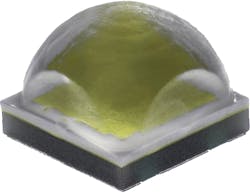Cree demonstrates 134-lm/W packaged LED with incandescent quality
A single high-power packaged LED has delivered nearly 1600 lm in a Cree laboratory demonstration that was based on the company's SC5 technology platform.
Cree has announced the results of laboratory tests of a single high-power packaged LED that delivered almost 1600 lm with light quality that matches the incandescent lamp. The company said the 134-lm/W realized efficacy is 25% better than other LEDs that can yield similar light quality. Generally, when Cree has publicized laboratory demonstrations, the company has delivered similar technology commercially about two years later.
Interested in more articles & announcements on packaged LEDs?
Ironically, Cree made the announcement on the eve of the Strategies in Light (SIL) conference and one year back a prior Cree laboratory announcement came under great scrutiny at SIL. Indeed, in 2014 Cree had announced that it exceeded 300 lm/W in a lab demonstration. And in an SIL 2015 keynote presentation, Jy Bhardwaj, senior vice president of research and development at Lumileds, spent significant time explaining that a 300-lm/W packaged LED was simply not feasible in a usable white CCT until some major roadblocks were hurdled by the industry.
It's impossible to know how or if Bhardwaj's SIL speech impacted Cree's technology and marketing plans. But the company had previously announced record efficacy milestones with admittedly cooler CCTs and lower CRI than might be desirable for commercial interior lighting. For example, Cree executive Norbert Hiller used an SIL keynote in 2013 to announce the 276-lm/W milestone for an LED in the 4000K-CCT range.
But the latest Cree efficacy milestone is different in that the lighting-quality targets are high. Cree said the demonstration was based on a packaged LED that could deliver 90 CRI or better and also 90 or better for the R9 saturated-red color sample that is so important in applications such as retail lighting. Moreover, the CCT target is the 2700K warm hue of the legacy incandescent.
"Today, advancing LED technology goes beyond just increasing lumens per watt," said John Edmond, Cree co-founder and director of advanced optoelectronics. "Cree is also focused on improving spectral content and the efficacy of warmer color temperatures while pursuing tremendous opportunities to increase lumens per watt at real-world operating conditions. This R&D result continues Cree’s high-power LED technology innovation and provides a path to better lighting experiences at the lowest overall system cost."
The Cree announcement is perhaps even more important, relative to some recent regulatory activity. The California Energy Commission (CEC) has adopted new rulemaking that will in fact require 90-CRI lamps beginning in 2018. We can't predict at this time whether California will be an outlier in that requisite, or if perhaps other parts of the US and regions around the globe will follow the state's lead as has happened with lamp-efficiency regulations.
In any event, Cree's demonstrated ability to deliver commercially on lab products in two years would synchronize nicely with the CEC Title 20 ruling. Cree said the packaged LED delivered 1587 lm at 350 mA of drive current and at a realistic temperature of 85°C. Cree hinted that the demonstration relied on the company's SC5 (silicon carbide 5) LED technology platform, although if experience is a guide the company will be at SC6 or SC7 two years hence.

Maury Wright | Editor in Chief
Maury Wright is an electronics engineer turned technology journalist, who has focused specifically on the LED & Lighting industry for the past decade. Wright first wrote for LEDs Magazine as a contractor in 2010, and took over as Editor-in-Chief in 2012. He has broad experience in technology areas ranging from microprocessors to digital media to wireless networks that he gained over 30 years in the trade press. Wright has experience running global editorial operations, such as during his tenure as worldwide editorial director of EDN Magazine, and has been instrumental in launching publication websites going back to the earliest days of the Internet. Wright has won numerous industry awards, including multiple ASBPE national awards for B2B journalism excellence, and has received finalist recognition for LEDs Magazine in the FOLIO Eddie Awards. He received a BS in electrical engineering from Auburn University.





